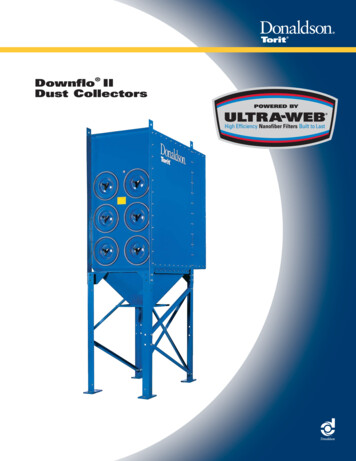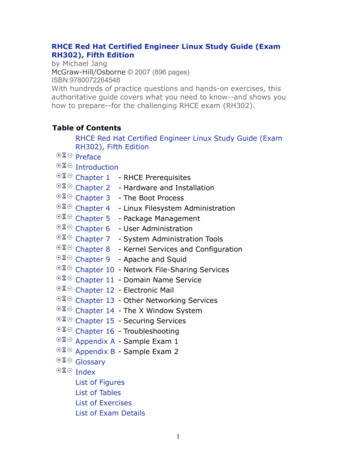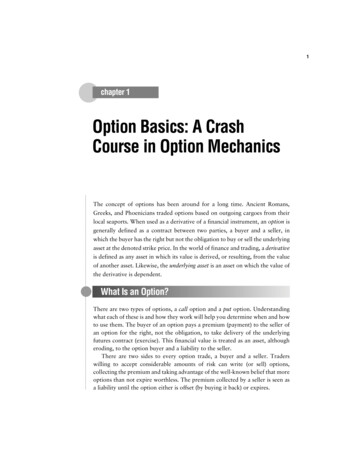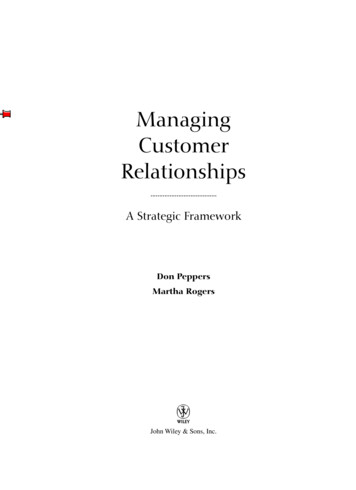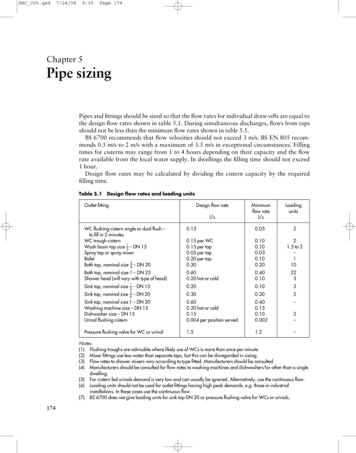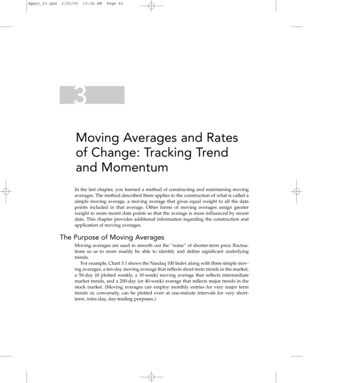
Transcription
Jang FM.qxd12/14/052:53 PMPage iLinux Patch Management
Jang FM.qxd12/14/052:53 PMPage iiBRUCE PERENS’ OPEN SOURCE SERIESwww.prenhallprofessional.com/perensN Java Application Development on Linux Carl Albing and Michael SchwarzN C GUI Programming with Qt 3Jasmin Blanchette and Mark SummerfieldN Managing Linux Systems with Webmin: System Administration and Module DevelopmentJamie CameronN Understanding the Linux Virtual Memory ManagerMel GormanN PHP 5 Power ProgrammingAndi Gutmans, Stig Bakken, and Derick RethansN Linux Quick Fix NotebookPeter HarrisonN Implementing CIFS: The Common Internet File SystemChristopher HertelN Open Source Security Tools: A Practical Guide to Security ApplicationsTony HowlettN Apache Jakarta Commons: Reusable Java ComponentsWill IversonN Linux Patch Management: Keeping Linux Systems Up To DateMichael JangN Embedded Software Development with eCosAnthony MassaN Rapid Application Development with MozillaNigel McFarlaneN Subversion Version Control: Using the Subversion Version Control System in DevelopmentNNNNNProjectsWilliam NagelIntrusion Detection with SNORT: Advanced IDS Techniques Using SNORT, Apache, MySQL,PHP, and ACIDRafeeq Ur RehmanCross-Platform GUI Programming with wxWidgetsJulian Smart and Kevin Hock with Stefan CsomorSamba-3 by Example, Second Edition: Practical Exercises to Successful DeploymentJohn H. TerpstraThe Official Samba-3 HOWTO and Reference Guide, Second EditionJohn H. Terpstra and Jelmer R. Vernooij, EditorsSelf-Service Linux : Mastering the Art of Problem DeterminationMark Wilding and Dan Behman
Jang FM.qxd12/14/052:53 PMPage iiiLinux Patch ManagementKeeping Linux Systems Up To DateMichael JangUpper Saddle River, NJ Boston Indianapolis San FranciscoNew York Toronto Montreal London Munich Paris MadridCapetown Sydney Tokyo Singapore Mexico City
Jang FM.qxd12/14/052:53 PMPage ivMany of the designations used by manufacturers and sellers to distinguish their products are claimed astrademarks. Where those designations appear in this book, and the publisher was aware of a trademarkclaim, the designations have been printed with initial capital letters or in all capitals.The author and publisher have taken care in the preparation of this book, but make no expressed or impliedwarranty of any kind and assume no responsibility for errors or omissions. No liability is assumed for incidental or consequential damages in connection with or arising out of the use of the information or programscontained herein.The publisher offers excellent discounts on this book when ordered in quantity for bulk purchases or specialsales, which may include electronic versions and/or custom covers and content particular to your business,training goals, marketing focus, and branding interests. For more information, please contact:U. S. Corporate and Government Sales(800) 382-3419corpsales@pearsontechgroup.comFor sales outside the U. S., please contact:International Salesinternational@pearsoned.comThis Book Is Safari EnabledThe Safari Enabled icon on the cover of your favorite technology book means the book isavailable through Safari Bookshelf. When you buy this book, you get free access to the onlineedition for 45 days. Safari Bookshelf is an electronic reference library that lets you easilysearch thousands of technical books, find code samples, download chapters, and access technical information whenever and wherever you need it.To gain 45-day Safari Enabled access to this book: Go to http://www.awprofessional.com/safarienabled Complete the brief registration form Enter the coupon code NIFZ-9PSE-SFJV-ZXEA-6J1SIf you have difficulty registering on Safari Bookshelf or accessing the online edition, pleasee-mail customer-service@safaribooksonline.com.Visit us on the Web: www.phptr.comLibrary of Congress Cataloging-in-Publication DataJang, MichaelLinux Patch Management : keeping Linux systems up to date / Michael Jang.p. cm.Includes index.ISBN 0-13-236675-41. Linux. 2. Operating systems (Computers) 3. Computer security. 4. Software maintenance. I. Title.QA76.76.O63J368 2006005.4’32—dc222005028070Copyright 2006 Pearson Education, Inc.All rights reserved. Printed in the United States of America. This publication is protected by copyright, andpermission must be obtained from the publisher prior to any prohibited reproduction, storage in a retrievalsystem, or transmission in any form or by any means, electronic, mechanical, photocopying, recording, or likewise. For information regarding permissions, write to:Pearson Education, Inc.Rights and Contracts DepartmentOne Lake StreetUpper Saddle River, NJ 07458ISBN 0-13-236675-4Text printed in the United States on recycled paper at R. R. Donnelley in Crawfordsville, Indiana.First printing, January 2006
Jang FM.qxd12/14/052:53 PMPage vMy dear Nancy, I miss you. I wish you were still here on thisearth with us. This world is less without you. I do my best to carryyour spirit with me. I will always love you.My dear Donna, thank you for finding me. Thank you for marrying me.I love you with all my heart. I will love you forever.“Where you lead, I will follow.” I thank your dearly departed Randy andmy dearly departed Nancy for helping us find each other.To the young widowed of the world, we will always grieve for our dearlydeparted mates. However, we can find happiness again.
Jang FM.qxd12/14/052:53 PMPage vi
Jang FM.qxd12/14/052:53 PMPage viiContentsAbout the AuthorxiiiPrefacexvAcknowledgmentsxxi1Patch Management Systems1.1 Basic Patch Concepts1.1.1 What Is a Patch?1.1.2 Patch Sources1.1.3 Patch Testing1.2 Distribution-Specific Repositories1.2.1 Red Hat Enterprise Linux Updates1.2.2 Novell/SUSE1.2.3 Debian1.2.4 Other Linux Distributions1.3 Community-Based Sources1.3.1 Fedora Linux1.3.2 Red Hat Rebuilds1.4 Configuring Your LAN1.4.1 Linux Patch Management in a Network1.4.2 Rigorous Hardware Requirements1.4.3 Source Packages1.4.4 More Than One Repository1.4.5 Keeping Your Repository Updated1.5 dating Patches on a Red Hat/Fedora Network2.1 Creating Your Own Fedora Repository2.1.1 Installation Requirements2.1.2 Creating a Repository43434450vii
Jang FM.qxd12/14/052:53 PMPage viiiviiiContents2.2 Configuring a Red Hat Network Proxy2.2.1 Configuring the Proxy Server2.2.2 Configuring the Proxy Client2.3 Configuring Red Hat Rebuilds2.3.1 CentOS2.3.2 Lineox2.3.3 Other Rebuilds2.4 Summary52526973747777783SUSE’s Update Systems and rsync Mirrors3.1 The YaST Update System3.1.1 The YaST Package Manager3.1.2 Change Source of Installation3.1.3 Installation Into Directory3.1.4 Patch CD Update3.1.5 System Update3.1.6 UML Installation3.1.7 YOU Server Configuration3.1.8 A Local YaST Online Update3.2 Configuring YaST Patch Management for a LAN3.2.1 Creating a Local Mirror with YaST Online Update Server3.2.2 Creating a Local Mirror with rsync3.3 ZENworks Linux Management3.3.1 Supported Clients and Servers3.3.2 Installing the ZLM Server3.3.3 Configuring the Web interface3.3.4 Configuring Administrators3.3.5 Adding Clients3.3.6 Setting Up Activations3.3.7 Creating Groups3.3.8 Configuring Channels3.3.9 Creating Transactions3.4 81101101111121134Making apt Work for You4.1 Fundamentals of apt4.1.1 Installing apt on a Debian-Based Distribution4.1.2 Installing apt on a RPM-Based Distribution4.1.3 Configuring apt on Your Computer4.1.4 The Basic apt Commands4.1.5 The aptitude System4.1.6 Running the Synaptic Package Manager115115115117117120124132
Jang FM.qxd12/14/052:53 PMPage ixContentsix4.2 Creating Your apt Repository4.2.1 Debian Repository Mirror Options4.2.2 A Complete Debian Repository4.2.3 Creating a Debian Mirror4.3 Summary1401401411441505Configuring apt for RPM Distributions5.1 A History of apt for RPM5.1.1 Reduced Dependency Trouble5.1.2 The Conectiva Approach5.1.3 An Overview of apt for RPM-Based Distributions5.2 Configuring apt for RPM5.2.1 Package Options5.2.2 Configuring apt5.2.3 Selecting Sources5.2.4 Configuring apt for Fedora Linux5.2.5 Configuring apt for SUSE Linux5.2.6 Configuring apt for a Red Hat Rebuild5.3 Setting Up a Local Repository5.3.1 Mirroring a Remote Repository5.3.2 Creating an apt Repository5.4 The apt Commands in Detail5.4.1 Analyzing apt-cache in Detail5.4.2 Analyzing apt-get in Detail5.4.3 Debian-Only apt Commands5.4.4 RPM-Only apt Commands5.5 701731731751771771776Configuring a yum Client6.1 The Basic yum Process6.1.1 Yellow Dog and yum6.1.2 yup and yum6.1.3 Repositories and Headers6.1.4 Required yum Packages6.2 Sample yum Clients6.2.1 Fedora6.2.2 Red Hat Enterprise Linux6.2.3 Red Hat Enterprise Linux Rebuilds6.3 Special yum Commands6.3.1 Caching Available Packages by yum6.3.2 Checking Available Updates by yum6.3.3 Finding a Needed File6.3.4 Identifying a Needed 98
Jang FM.qxd12/14/052:53 PMPage xx7Contents6.3.5 Listing Available Packages6.3.6 Getting More Information6.3.7 Updates or Installations by yum6.3.8 Deletions by yum6.3.9 Cleaning yum Caches6.3.10 Group Management by yum6.3.11 The yum Command Options6.4 Configuring Automatic Updates6.4.1 Finding the Right Update Command6.4.2 Automating the Process6.4.3 Other Automated Updates6.5 A yum GUI Tool6.5.1 Basic Configuration6.5.2 Adding More Repositories6.5.3 Installing Packages6.5.4 Updating Packages6.5.5 Removing Packages6.5.6 Using Your Own Commands6.6 13214215215216Setting Up a yum Repository7.1 Getting the Packages7.1.1 Strategy7.1.2 Creating a yum Directory Tree7.1.3 Start with a Distribution7.1.4 Installing yum7.1.5 Synchronizing Updates7.2 Managing Headers7.2.1 Header Creation Commands7.2.2 Adding the Headers7.3 Configuring a Local yum Server7.3.1 Configuring an FTP yum Server7.3.2 Configuring a yum Client for an FTP-Based yumRepository7.3.3 Configuring an NFS yum Server7.3.4 Configuring an NFS yum Client7.4 Adding Other Repositories7.4.1 Using Distribution Installation Files7.4.2 Keeping Extras with yum7.4.3 Adding Development Repositories7.4.4 Other Distribution Repositories7.4.5 Third-Party Repositories7.5 Maintaining the Repository7.5.1 Updating Packages7.5.2 Cleaning Header 233235237237237239240241241241242
Jang FM.qxd12/14/052:53 PMPage xiContents7.6 Creating an Enterprise Repository7.6.1 Creating a RHEL Update Repository7.6.2 Yummifying the RHEL Update Repository7.6.3 Sharing the RHEL Repository7.6.4 Configuring Updates to the RHEL Repository7.6.5 Configuring Clients to Use the RHEL Repository7.7 SummaryIndexxi242243248248250251251253
Jang FM.qxd12/14/052:53 PMPage xii
Jang FM.qxd12/14/052:53 PMPage xiiiAbout the AuthorMichael Jang holds RHCE, SAIR Linux Certified Professional, CompTIALinux Professional, and MCP certifications, and has written books on fourLinux certifications. A full-time writer specializing in networks and operatingsystems, his most recent book is Mastering Red Hat Enterprise Linux 3(Sybex, 2004).xiii
Jang FM.qxd12/14/052:53 PMPage xiv
Jang FM.qxd12/14/052:53 PMPage xvPrefaceWelcome to Linux Patch Management! This is the book that can guide youthrough managing patches and updates on one Linux computer or networks ofLinux computers.WHAT THIS BOOK IS ABOUTIt’s important to keep Linux computers up to date. Linux developers are constantly updating key services to enhance security, add features you need, fixbugs that hinder your productivity and the productivity of your users, andhelp your systems to work more efficiently. These updates are known aspatches. Most Linux distributions make gigabytes of patches available overthe Internet. These updates cannot help you unless you know how to managepatches for the different Linux systems on your network.This book assumes you have some sort of high-speed Internet connectionthat can help you download these patches. You may need to download hundreds of megabytes of patches, and that is not realistic on a 56Kbps telephonemodem. If you have to download hundreds of megabytes on all the Linux computers in your office, you might overload all but the fastest business-qualityhigh-speed connections.In this book, I describe how you can manage patches on Red Hat/Fedora,SUSE, and Debian Linux systems. While Red Hat and SUSE have developedspecialized update tools for their distributions, it’s also possible to use community tools, such as apt and yum, on many Linux distributions.To this end, you can use this book as a guide to managing patches on thenoted distributions. In addition, you can use apt and yum on a number of otherLinux systems. As a Linux administrator, you can use this book to learn tomanage the hundreds of megabytes, or even gigabytes, of patches on a widevariety of Linux systems.After you learn to manage patches on individual Linux systems, you canextend those skills to managing a group of Linux computers on a network. Ifxv
Jang FM.qxd12/14/052:53 PMPage xvixviPrefaceyou have a sufficient number of Linux systems, you may even want to buildyour own patch management repositories.Patches on one or two Linux computers may work well with a standardhigh-speed Internet connection. If you have a substantial number of Linuxcomputers, you might download the patches from each of these computers overthe Internet. To keep these downloads from overloading your Internet connection, you can pay a premium for an even higher-speed connection.Alternatively, you can use the techniques described in this book to configure a local patch management repository. This can help you avoid buying afaster high-speed Internet connection. Thus, a patch management repositorycan help you save a lot of money. In addition, you can update a group of computers more quickly when you download patches from a local repository.Red Hat supports patch management on a group of Red Hat EnterpriseLinux (RHEL) computers through the Red Hat Network. SUSE supportspatch management on a group of SUSE Enterprise Linux Server andWorkstation computers with YaST Online Update and Zenworks LinuxManagement. You can use these tools to manage patches on individual systems or on networks of these distributions. Red Hat and SUSE provide thesetools to help you manage patches. If you have a large number of systems, thesetools can help you keep the loads on your Internet connection to a minimumand speed up the updates you need.But this book is not limited to Red Hat and SUSE Linux. It also can helpyou keep the loads on your Internet connection to a minimum when managingother distributions, including Debian and Fedora Linux. It also uses the toolsdesigned by Conectiva (now Mandriva) for RPM-based distributions. Theskills you learn can help you manage patches on allied distributions, includingYellowdog, Ubuntu, Progeny, Lycoris, and the “rebuild” distributions that usethe source code released for Red Hat Enterprise Linux.WHAT YOU NEED TO KNOW BEFORE READING THIS BOOKThis book assumes you have some experience with Linux. While it does notrequire that you have a network of Linux computers, you can take full advantage of the techniques described in this book only if you have such a network.Some of the tools described in this book require a subscription. For example, access to the Red Hat Network Proxy Server requires a specialized subscription to the Red Hat Network. Access to SUSE Linux Enterprise Serverupdates requires subscription access to the YaST Online Update Server.Access to Novell’s Zenworks Linux Management also requires a subscription.If you want to try out these tools, navigate to the associated Web sites. Trialsubscriptions may still be available. And read this book!Some of the tools described in this book are freely available. They arealready included with many Linux distributions. Some have been customized
Jang FM.qxd12/14/052:53 PMPage xviiPrefacexviiby third parties for popular distributions, such as Red Hat EnterpriseLinux. They are designed and maintained by the Linux community and areavailable courtesy of the GNU General Public License (http://www.gnu.org/copyleft/gpl.html).WHO YOU ARE, AND WHYANDHOW YOU SHOULD READ THIS BOOKThis book is designed for experienced and budding Linux administrators.Patch management is a critical Linux administration skill. This book can helpyou manage patches on individual Linux systems and can help you managepatches on networks of Linux computers.With these skills, you can keep your Linux systems up to date with the latest security, feature, and bug updates. You can keep a network of Linux systemsup to date in this way with a minimum load on your Internet connection.If your experience is limited to one or two Linux computers, this book canhelp you think beyond them to network management and what you will needto do in the workforce for a large group of Linux systems.You can use this book to evaluate the patch-management features associated with several different distributions. The more patch management toolsyou know, the more you can do to maintain different Linux distributions onyour network. For a general overview of patch management clients, readChapter 1, “Patch Management Systems.”If you’re evaluating patch management using the Red Hat Network andthe associated Proxy Server, read Chapter 2, “Consolidating Patches on a RedHat/Fedora Network.” If you’re evaluating patch management using the YaSTOnline Update Server or Zenworks Linux Management, read Chapter 3,“SUSE’s Update Systems and rsync Mirrors.” You’ll also find information onhow you can use rsync to mirror repositories from most all Linux distributions.If you’re evaluating patch management on Debian Linux systems, readChapter 4, “Making apt Work for You.” As Knoppix and Ubuntu are built onDebian, the same tools can help you manage systems associated with thosedistributions, as well. You’ll learn how to create a Debian repository on yourown network.If you prefer the apt patch management commands associated withDebian Linux, you can also use them on many RPM-based distributions. Ifthat is what you want, read Chapter 5, “Configuring apt for RPMDistributions.” That chapter will show you how to create an apt-based repository for a RPM-based distribution on your own network.If you prefer the affinity of yum for RPM-based distributions, readChapters 6 and 7. Chapter 6, “Configuring a yum Client,” details how you canuse yum to keep your systems up to date. Chapter 7, “Setting Up a yumRepository,” details how you can create yum repositories on your own network.
Jang FM.qxd12/14/052:53 PMPage xviiixviiiPrefaceHOW THIS BOOK IS LAID OUTHere is a brief summary of all the chapters: Chapter 1 provides a basic overview of how you can manage patches on an individual Linux system. Techniques that we describe cover RHEL,SUSE Linux (formerly known as SUSE Linux Professional), SUSE LinuxEnterprise Server, Debian Linux, Fedora Linux, and some of the rebuildsof RHEL. This chapter also previews some of the tools you can use to create a patch management repository on your own network.Chapter 2 starts by providing a model of how you can create a repositoryfor Fedora Linux. It continues with a focus on the Red Hat Network,specifically the associated Proxy Server, which can help you cacheupdates. It also adds more detail on how you can manage patches on systems with RHEL rebuild distributions.Chapter 3 is focused on the patch management tools created by SUSEand Novell for their Linux systems. It also describes how you can usersync to mirror update servers for all Linux distributions. You can pointYaST Online Update to a variety of local or network sources, such as alocal patch management server, which you can copy from the mirror ofyour choice. Finally, we describe how Zenworks Linux Management canbe installed on SUSE Linux Enterprise Server or even RHEL to administer patches on a variety of SUSE and RHEL clients.Chapter 4 guides you through the fundamentals of the apt commands,along with their capabilities. By the time you complete this chapter,you’ll know how to use various apt commands, the aptitude utility, andthe GUI Synaptic Package Manager to manage your system. Finally, thischapter guides you through different tools available for downloading andsynchronizing your local repository with the mirror of your choice.Chapter 5 helps you learn to install and use many of the apt tools fromChapter 4 on RPM-based distributions, such as Fedora and SUSE Linux.Based on the work of Conectiva (now Mandriva) Linux, you can use thetools described in Chapter 5 to create and maintain an apt repository forseveral different RPM-based distributions.Chapter 6 supports the use of yum as a client on RPM-based distributions. Many Linux users prefer yum because of its Python-based compatibility with RPM systems. It’s now the default update tool for FedoraLinux. You can even install and use yum on RHEL (and rebuild distributions). While GUI tools for yum are not yet stable, the Yum Extenderappears to be most promising.Chapter 7 helps you design, populate, and manage your own yumRepository on a RHEL computer. You can use this repository to maintainFedora Linux systems. It includes guidelines that can help you minimize
Jang FM.qxd12/14/052:53 PMPage xixPrefacexixthe downloads required to create the repository. Finally, if you haveauthorized subscriptions, this chapter provides instructions on how youcreate a yum repository for a network of RHEL computers.CONVENTIONS USEDCommand line operations are called out with a monospaced font. The promptis assumed; for example, the following command would be run at a Linux command line interface:up2date --show-channelCommands are often included in the text of a paragraph in a similarmonospaced font. For example, if you see up2date --show-channel, you couldtype that text in a command line interface.Many URLs in this book do not include a prefix such as http://, unless thecontext is not obvious. For example, when we refer to the vsFTP home page atvsftpd.beasts.org, we are referring to the associated Web page. But remember,there are other TCP/IP ports and prefixes, such as ftp://, rsync://, and file:///.Long commands are written on multiple lines for clarity (as shown here),but should be typed on one line. A backslash (\) is inserted in the line to indicate that it is all one line; for example,rsync -av --exclude debug i386/* \/var/ftp/pub/yum/3/i386/updates/Notes, Warnings, and Tips appear in the text as follows:NoteParticular points that need to be emphasized appear in a box to alert you.WARNINGThe warning box is used to emphasize an issue or concern that might be encountered and should be avoided.TipA box labeled with the above denotes information that is specifically useful.
Jang FM.qxd12/14/052:53 PMPage xx
Jang FM.qxd12/14/052:53 PMPage xxiAcknowledgmentsWhile it is my name on the cover, the production of a book is a team effort.Outside of the team, I’d also like to thank Todd Warner of Red Hat, as well asMartin Buckley, Sascha Wessels, Marissa Krupa, and Jasmin Ul-Haque ofNovell/SUSE for their help.Naturally, Linux would not have the world-class patch management toolswithout its world of dedicated developers. The Debian developers behind apt,the Yellowdog developers behind yum, the Conectiva (now Mandriva) developers who brought apt to RPM-based distributions, as well as those who haveadded to the associated tools, all deserve special thanks.Also important to this process are the editors at Prentice Hall: ChrisZahn, Jill Harry, Karen Gettman, Ebony Haight, Michael Thurston, EliseWalter, and Debbie Williams. I could not have made this book into a qualitywork without the reviews of Elizabeth Zinkann, Joe Brazeal, Matthew Crosby,Bret Strong, George Vish, Aaron Weber, and Fabien Gandon. This book wouldnot have been possible except for the vision of the Open Source Series editor,Bruce Perens.xxi
Jang FM.qxd12/14/052:53 PMPage xxii
Jang ch01.qxd12/14/051:14 PMPage 1C H A P T E R1Patch Management SystemsIt’s important to keep Linux systems up to date. Updates can help you keepyour systems secure, help you fix problems, and help you incorporate thenewest features. Updates in the world of computers are also known aspatches.In this chapter, we’ll examine the basics of patch management, how youcan apply patches to your computer, and where you should get patches for several Linux distributions. Patch management methods vary by distribution. Ifyou’re paying for support from Red Hat or SUSE, you’re paying in part forsupport through their patch management systems. If you’re using anotherLinux distribution, there are solid freely available alternatives.When you administer a network, you’re responsible for updates on anumber of computers. You could configure each of these computers to get theirupdates automatically, but that might overload your network and connectionto the Internet. In later chapters, we will show you how to configure a patchmanagement repository for your network.1.1BASIC PATCH CONCEPTSIn the world of Linux, patches are more than just something you might applyto the source code of a kernel. They include the updates that can help you keepyour systems secure, error-free, and updated with the latest features.Before we continue, it’s important to define the concept of a patch andnote the variety of sources from where you can download patches for yourcomputer systems.1.1.1What Is a Patch?A patch is an update. It incorporates changes in source code. Patches are normally applied to specific software components, such as the kernel, or a service,such as vsFTP. Patches may fix bugs, address security issues, or incorporate1
Jang ch01.qxd212/14/051:14 PMPage 2Patch Management SystemsChapter 1new features. As an administrator, you’re responsible for testing the new software, making sure that it addresses any problems before your users see themon their systems.In general, when you patch a program, service, or system, you’ll beupgrading a package. Some Linux distributions can be configured to warn youwhen patches for installed software are available. We’ll show you how to configure this in later chapters.Security FixesThe most important patches address security problems. This is where theLinux development model shines. Developers start working on a patch almostimmediately after a security issue is revealed. The process is public, whichreassures those concerned about the quality of the patch. As a result, securitypatches are often available in hours.If you’re administering a Linux computer, you need to keep up to date onthe latest security issues. If you’ve paid for a subscription to a Red Hat or aSUSE distribution, you can get email warnings about security problems withyour installed services. Other distributions may make alerts available byemail or through their mailing lists. Problems with services are oftenannounced on major Linux news sites, such as www.linuxtoday.com.Service UpgradesUsers will always demand upgrades. And Linux developers will respond. I suspect that after someone finds a way to use Linux to toast bread, another developer will start working on how to upgrade Linux into a bread maker.More practically, if someone developed a way to make Samba on Linuxemulate a Microsoft Active Directory domain controller (which is in work forSamba 4.0, per , therewould be a lot of demand for that service. You would likely find yourself downloading that package on a substantial number of computers.In general, programs that are released with new features get a lot ofdemand. Unfortunately, bugs are most likely to be found when a program isreleased with new features.Just remember, the developers of a service are usually different from thedevelopers of a distribution. So if you have a problem with a service, the faultmay not be with the developers at Red Hat, SUSE, Debian, and so on.Bug FixesIf software were perfect, I think there would not be so much work in computing, especially at Microsoft. A lot of work goes into diagnosing and repairingbuggy programs. Fortunately, the same infrastructure which leads to quicksecurity fixes also leads to quick bug fixes for open source Linux programs.When users report problems, they’re likely to demand quick solutions.The previous performance of Linux developers in finding quick solutions leadsto increased expectations for quick bug fixes. As an administrator, you’ll beexpected to roll out patches quickly, reliably, and securely.
Jang ch01.qxd12/14/051.11:14 PMPage 3Basic Patch Concepts3Kernel PatchesPatches to the Linux kernel are of a special kind. They include the changes insource code between consecutive versions of a kernel. For example, if you wantto upgrade from kernel version 2.6.15 to 2.6.16, you should apply patch-2.6.16to your current kernel.There are special requirements associated with kernel patches. Generally,they work only with the kernel as released through www.kernel.org. The peoplebehind some distributions build their kernels with different features. NativeLinux kernel patches may lead to conflicts, lost features, or even kernel panics.Standard Linux kernel patches require that you adjust perhaps dozens ofsettings and then compile that kernel in binary format. This process can takehours, and is therefore something that you may not want to repeat. ManyLinux distributions include preconfigured kernels in their repositories thatyou can use to upgrade your systems without having to compile them.NoteDebian-based Linux distributions make it easy for you to set up a binary kernelfrom recompiled code, which you can then use to upgrade other Debian-based systems on your network.Kernel UpgradesBecause the kernel is so important to the operating system, you should nottake chances. It’s best to upgrade Linux kernels by installing them s
This Book Is Safari Enabled The Safari Enabled icon on the cover of your favorite technology book means the book is available through Safari Bookshelf.When you buy this book, you get free access


